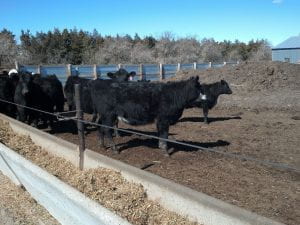by Monte Vandeveer, extension agricultural economist, Garden City
One price risk management tool available to feeder cattle producers (and other types of livestock producers) is Livestock Risk Protection, or LRP. The LRP program from USDA’s Risk Management Agency (RMA) is a price insurance program where insurance policies are sold through local insurance agencies but still backed up by RMA, just like traditional crop insurance. Also like multi-peril crop insurance, LRP premiums receive a subsidy through RMA.
Recent changes to the LRP program were announced in a news release from RMA on April 22, 2019, and these changes will take effect July 1, 2019. The cattle-related changes to LRP include the following:
- Expansion of LRP coverage for fed and feeder cattle to all states (the northeastern U.S. was formerly excluded);
- An increase in the LRP premium subsidy from 13 percent for all coverage levels to a subsidy that ranges from 20 percent to 35 percent, depending on the coverage level selected;
- The Chicago Mercantile Exchange (CME) trading requirements were updated to allow for more insurance endorsement lengths (that is, to allow a greater number of time periods to be covered by the insurance);
- Increased the annual limit for number of head which can be insured to 3,000 head per endorsement and 6,000 head per year, for both feeder cattle and fed cattle;
- Change the “Price Adjustment Factor” for dairy cattle to 50 percent for both light-weight and heavy-weight cattle.
For readers not familiar with LRP, it is a risk management tool which has been around for a number of years, though not always widely used. LRP operates as price insurance that protects producers against declining cattle prices. That is, producers pay an insurance premium and in return receive coverage which pays when the CME price falls below the threshold price selected by the producer.
Along with feeder cattle, LRP is available for fed cattle, lambs, and swine. For feeder cattle, there are two weight classes for LRP: animals weighing less than 600 pounds at the end of the insurance period, and those weighing 600 to 900 pounds. As mentioned, producers may insure up to 6,000 head per year. The market price utilized by LRP coverage is the CME feeder cattle index price, so basis risk (the difference between local prices and the futures price) is not covered by LRP.
One advantage of LRP is that the number of head insured at one time does not have to match the number implied by the weights for the CME futures and options contracts. That is, the CME feeder cattle futures contract has a specified weight of 50,000 pounds, which amounts to about 83 head of 600-lb. animals. LRP allows producers to insure cattle lots of different size, which may be particularly useful to producers dealing with smaller groups of animals.
Another advantage of LRP is that its premiums are subsidized. Table 1 shows the new premium subsidy rates which will take effect on July 1. As mentioned, all LRP premiums were previously subsidized at 13 percent, but future subsidies will range from 20 to 35 percent, with lower coverage levels receiving higher premium subsidy rates.
Table 1. Premium subsidy rates for LRP insurance, by coverage level
| Coverage level: % of expected price | Premium subsidy rate (% of total premium) |
| 70-79% | 35% |
| 80-89% | 30% |
| 90-94.9% | 25% |
| 95-100% | 20% |
The Risk Management Agency has several publications and web pages of interest to producers wanting to learn more about LRP:
- LRP fact sheet about price insurance for feeder cattle
- List of all types of livestock coverage from RMA, including LRP
- LRP Specific Coverage Endorsement for feeder cattle
- Livestock Reports webpage, which reports coverage prices, premium rates, etc.
K-State Research and Extension has a spreadsheet (K-State Feeder Cattle Risk Management Tool) for comparing strategies to manage price risk for feeder cattle. It includes LRP as one approach, and also calculates returns for a cash position, a futures short hedge, a put option, a futures short hedge plus a call option (called a “synthetic put”), and a combination of put and call options. It was recently updated to reflect the premium subsidy rate changes that will take effect on July 1.
Returns to LRP will look quite similar to those offered by a traditional put option. When market price drops below the LRP coverage price (analogous to the strike price for a put option), then an LRP indemnity will compensate the insured back up to the level of the coverage price. When market prices remain above the coverage price, the LRP coverage expires worthless, and the producer must also pay the premium.
Feeder cattle prices have been in a rather steep and steady decline since late April, and with all the late planting concerns in the Corn Belt, producers may see even more downward pressure on calf prices if the expected corn crop continues to shrink and corn prices rise. LRP offers one way to protect against further calf price declines without forfeiting upside price potential.